湖北辛亥革命博物馆导游词
- 格式:doc
- 大小:29.00 KB
- 文档页数:6
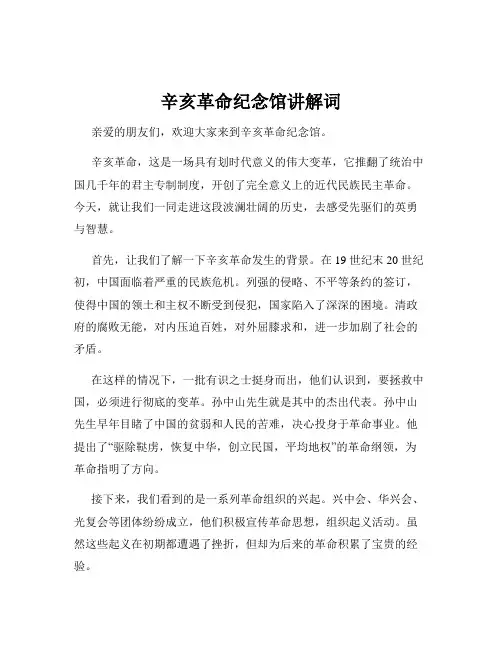
辛亥革命纪念馆讲解词亲爱的朋友们,欢迎大家来到辛亥革命纪念馆。
辛亥革命,这是一场具有划时代意义的伟大变革,它推翻了统治中国几千年的君主专制制度,开创了完全意义上的近代民族民主革命。
今天,就让我们一同走进这段波澜壮阔的历史,去感受先驱们的英勇与智慧。
首先,让我们了解一下辛亥革命发生的背景。
在 19 世纪末 20 世纪初,中国面临着严重的民族危机。
列强的侵略、不平等条约的签订,使得中国的领土和主权不断受到侵犯,国家陷入了深深的困境。
清政府的腐败无能,对内压迫百姓,对外屈膝求和,进一步加剧了社会的矛盾。
在这样的情况下,一批有识之士挺身而出,他们认识到,要拯救中国,必须进行彻底的变革。
孙中山先生就是其中的杰出代表。
孙中山先生早年目睹了中国的贫弱和人民的苦难,决心投身于革命事业。
他提出了“驱除鞑虏,恢复中华,创立民国,平均地权”的革命纲领,为革命指明了方向。
接下来,我们看到的是一系列革命组织的兴起。
兴中会、华兴会、光复会等团体纷纷成立,他们积极宣传革命思想,组织起义活动。
虽然这些起义在初期都遭遇了挫折,但却为后来的革命积累了宝贵的经验。
1911 年 10 月 10 日,武昌起义的枪声打响,这成为了辛亥革命的开端。
起义军迅速占领了武昌城,并成立了湖北军政府。
武昌起义的成功,如同星星之火,迅速在全国范围内形成燎原之势。
各地纷纷响应,宣布独立,脱离清政府的统治。
在革命的进程中,涌现出了许多英勇无畏的人物。
比如黄兴,他在多次战斗中身先士卒,为革命事业立下了赫赫战功。
还有宋教仁,他为了建立民主共和的政治制度,不懈努力,奔走呼号。
辛亥革命的成功,结束了中国长达两千多年的君主专制制度,建立了中华民国。
它使得民主共和的观念深入人心,极大地推动了中国社会的进步和发展。
然而,辛亥革命的成果并没有得到完全的巩固。
袁世凯窃取了革命的果实,妄图复辟帝制。
但历史的潮流是不可阻挡的,在全国人民的反对声中,他的复辟美梦最终破灭。
辛亥革命虽然没有彻底改变中国半殖民地半封建社会的性质,但它为中国共产党的成立奠定了基础,为中国的现代化进程开辟了道路。
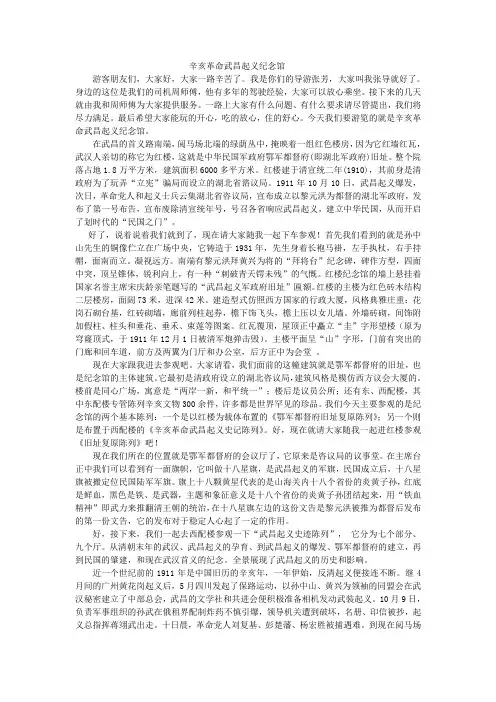
辛亥革命武昌起义纪念馆游客朋友们,大家好,大家一路辛苦了。
我是你们的导游张芳,大家叫我张导就好了。
身边的这位是我们的司机周师傅,他有多年的驾驶经验,大家可以放心乘坐。
接下来的几天就由我和周师傅为大家提供服务。
一路上大家有什么问题、有什么要求请尽管提出,我们将尽力满足。
最后希望大家能玩的开心,吃的放心,住的舒心。
今天我们要游览的就是辛亥革命武昌起义纪念馆。
在武昌的首义路南端,阅马场北端的绿荫丛中,掩映着一组红色楼房,因为它红墙红瓦,武汉人亲切的称它为红楼,这就是中华民国军政府鄂军都督府(即湖北军政府)旧址。
整个院落占地1.8万平方米,建筑面积6000多平方米。
红楼建于清宣统二年(1910),其前身是清政府为了玩弄“立宪”骗局而设立的湖北省谘议局。
1911年10月10日,武昌起义爆发,次日,革命党人和起义士兵云集湖北省咨议局,宣布成立以黎元洪为都督的湖北军政府,发布了第一号布告,宣布废除清宣统年号,号召各省响应武昌起义,建立中华民国,从而开启了划时代的“民国之门”。
好了,说着说着我们就到了,现在请大家随我一起下车参观!首先我们看到的就是孙中山先生的铜像伫立在广场中央,它铸造于1931年,先生身着长袍马褂,左手执杖,右手持帽,面南而立。
凝视远方。
南端有黎元洪拜黄兴为将的“拜将台”纪念碑,碑作方型,四面中突,顶呈锥体,锐利向上,有一种“刺破青天锷未残”的气慨。
红楼纪念馆的墙上悬挂着国家名誉主席宋庆龄亲笔题写的“武昌起义军政府旧址”匾额。
红楼的主楼为红色砖木结构二层楼房,面阔73米,进深42米。
建造型式仿照西方国家的行政大厦,风格典雅庄重:花岗石砌台基,红砖砌墙,廊前列柱起券,檐下饰飞头,檐上压以女儿墙。
外墙砖砌,间饰附加假柱、柱头和垂花、垂禾、束莲等图案。
红瓦覆顶,屋顶正中矗立“圭”字形望楼(原为穹窿顶式,于1911年12月1日被清军炮弹击毁)。
主楼平面呈“山”字形,门前有突出的门廊和回车道,前方及两翼为门厅和办公室,后方正中为会堂。

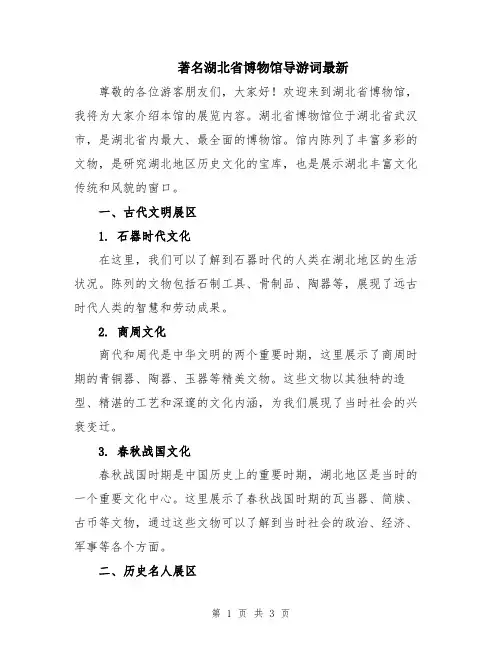
著名湖北省博物馆导游词最新尊敬的各位游客朋友们,大家好!欢迎来到湖北省博物馆,我将为大家介绍本馆的展览内容。
湖北省博物馆位于湖北省武汉市,是湖北省内最大、最全面的博物馆。
馆内陈列了丰富多彩的文物,是研究湖北地区历史文化的宝库,也是展示湖北丰富文化传统和风貌的窗口。
一、古代文明展区1. 石器时代文化在这里,我们可以了解到石器时代的人类在湖北地区的生活状况。
陈列的文物包括石制工具、骨制品、陶器等,展现了远古时代人类的智慧和劳动成果。
2. 商周文化商代和周代是中华文明的两个重要时期,这里展示了商周时期的青铜器、陶器、玉器等精美文物。
这些文物以其独特的造型、精湛的工艺和深邃的文化内涵,为我们展现了当时社会的兴衰变迁。
3. 春秋战国文化春秋战国时期是中国历史上的重要时期,湖北地区是当时的一个重要文化中心。
这里展示了春秋战国时期的瓦当器、简牍、古币等文物,通过这些文物可以了解到当时社会的政治、经济、军事等各个方面。
二、历史名人展区1. 孙武和诸葛亮孙武和诸葛亮是中国历史上最伟大的军事家和政治家,他们对中国的历史进程和文化发展产生了深远的影响。
这里展示了他们的兵器、书信、典籍等文物,带领我们回顾他们的伟大事迹和智慧思想。
2. 李白和屈原李白是唐代诗人,被誉为“诗仙”,他的诗作达到了至高的艺术境界。
屈原是战国时期的伟大诗人,他的《离骚》被誉为中国文化的瑰宝。
这里展示了他们的手迹、诗集等文物,通过这些文物我们可以欣赏到他们优美的诗作,并了解他们的人生故事。
三、民俗文化展区1. 汉字文化中国的汉字是世界上最古老也是最复杂的文字之一,这里展示了汉字的演变历程、印刷技术的发展、名家书法等内容。
通过这些展示,我们可以了解到汉字的起源和演变,并领略到中国传统书法的魅力。
2. 风俗文化中国是一个多民族的国家,每个民族都有自己独特的风俗文化。
在这里,我们可以了解到湖北地区的传统民俗,如汉服、武术、民间艺术等。
这些传统文化代表了中国人民的智慧和创造力,也是中华文化宝库中的瑰宝。
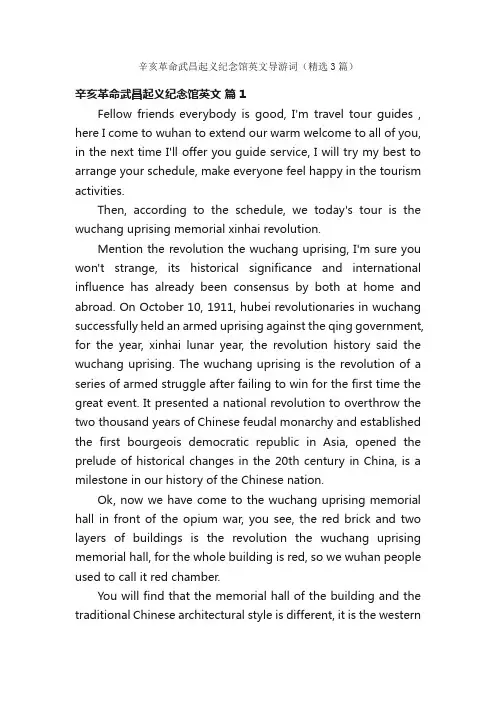
辛亥革命武昌起义纪念馆英文导游词(精选3篇)辛亥革命武昌起义纪念馆英文篇1Fellow friends everybody is good, I'm travel tour guides , here I come to wuhan to extend our warm welcome to all of you, in the next time I'll offer you guide service, I will try my best to arrange your schedule, make everyone feel happy in the tourism activities.Then, according to the schedule, we today's tour is the wuchang uprising memorial xinhai revolution.Mention the revolution the wuchang uprising, I'm sure you won't strange, its historical significance and international influence has already been consensus by both at home and abroad. On October 10, 1911, hubei revolutionaries in wuchang successfully held an armed uprising against the qing government, for the year, xinhai lunar year, the revolution history said the wuchang uprising. The wuchang uprising is the revolution of a series of armed struggle after failing to win for the first time the great event. It presented a national revolution to overthrow the two thousand years of Chinese feudal monarchy and established the first bourgeois democratic republic in Asia, opened the prelude of historical changes in the 20th century in China, is a milestone in our history of the Chinese nation.Ok, now we have come to the wuchang uprising memorial hall in front of the opium war, you see, the red brick and two layers of buildings is the revolution the wuchang uprising memorial hall, for the whole building is red, so we wuhan people used to call it red chamber.You will find that the memorial hall of the building and the traditional Chinese architectural style is different, it is the westernarchitectural style, is this why? It also speak of from the historical background of construction of the building.The initial production, is the qing government set up for playing the constituent scheme consultations, hubei province bureau of the site. Under the strong demand of the national bourgeoisie, the supreme ruler of qing dynasty, empress dowager cixi pressure from the outside world, also in order to cope with the revolution, made the constitutional position. So in 1906, the qing government announced the preparatory constitutional, declared in Beijing set up a client ZhengYuan, provincial bureau of consultations, as the central and local consultation and the institutions. Hubei consultations bureau set up in 1908, built in 1910. Architecture in the west of the house style. Red chamber, "the government of the wuchang uprising" and "revolution of the wuchang uprising memorial hall" two stone plaques are inscribed by soong ching ling.Below, please follow me to go to take a look inside.In the 19th century, is the world's fast developing period of modern industrial civilization, is also the demise of the feudal society of our country, the western powers with shells and opium broke the door of the qing government, China and closed by a unified feudal country reduced to a semi-colonial and semi-feudal country, with each to sign unequal treaties and the imperialist powers carved up, out to the people with lofty ideals for national independence and social progress advance wave upon wave, unremitting efforts, the whole of China is about to usher in a revolution in the storm.So how did the revolution in wuhan will fire the first gun? About this or let's have a look at the current state of the wuhan first: from the economic base, wuhan is the most prosperous,most new ideas at the time and one of the areas of economic strength; From the political point of view, when most of the revolutionaries of hubei took part in the various revolutionary groups, early contact with revolutionary ideas, and has the action of the courage and the will.So let's take a look at the exhibition hall of wuchang uprising of historic exhibition "revolution", let's flip through a long history, to understand the revolution to the wuchang uprising this period of history.The xinhai revolution, the fuse is the wuchang uprising movement to protect railway in May 1911, the qing government to borrow a railway state the name, will have to run by the local han, sichuan YueHan railway nationalised, and by way of mortgage, sold to Britain, France, Germany, the United States the four countries, aroused the four provinces of sichuan, hubei, guangdong, hunan people's opposition. On June 17, revolutionaries set up sichuan road associations, signed a petition is being suppressed. On September 2, the qing government rushed to oversee, while, sichuan YueHan railway minister led part of the hubei new army to sichuan suppressed, the qing forces moving westward, emptiness, to the force that causes the rule of hubei province under the influence of the brothers, literature and have decided to use the favorable opportunity, joint armed uprising.After the scheduled time is launched on October 6, due to the south lake cannon team events, strengthens the security, the qing army and plans haven't finished, so decide to extend the insurrection. On 9 October afternoon, sun wu, etc in hankou concession Russia treasure good manufacture bombs, inadvertently caused explosion, sun wu wounded, hankou totalauthority on the surface. Police in hankou composed of three big search, then night 1:00, be aboard the qing army, immediately sent troops to envelop, Peng Chufan, Liu Fuji, Yang Hongsheng more than 30 people have been arrested. On October 10 in the morning, peng, liu, Yang, three people were killed, wuchang city gate closed, the qing to continue the manhunt for the city, the situation is very critical. Revolutionary decided to cross the rubicon, crushed an uprising in the night.At 8 o 'clock in the evening, revolutionary Xiong Bingkun shot and killed a he long, in the camp heard gunshots, response quickly occupied the snake mountain and so on high ground, mulling three ways offensive HuGuang praetorium and eighth town command. Battle played hard, until 11 in the morning, the revolutionary forces occupied the wuchang town, condensing the blood of countless revolutionaries of nine Angle of 18 flag finally flies on the yellow crane tower.In the evening, hanyang, hankou successively occupied by revolutionaries, thus the whole wuhan city was controlled by revolutionaries.On October 11, 1911, part of the revolutionaries and the uprising troops gathered in consultations office building, the revolutionary party thinks, is not only the wuchang uprising, must immediately electrify the nation, calling for a response. They want to have a greater reputation can represent their electricity across the country, charisma and influence will be greater, so the original qing 21 composite association at the head of the li is pushing as army chief of hubei, and hubei military government. Here is the DouDuFu at that time, the military government of hubei province.Here you can see, a collection of many precious xinhairevolution relics, I this is around 18 flag, is the wuchang uprising in 1911 revolutionary ensign. The full name of iron eighteen flag (also known as nine flag). Kyushu earth pattern signifies iron spirit, said people awakening, joint inside shanhaiguan pass 18 provinces of Chinese descent, determined to overthrow the qing dynasty ruled by force. The revolution in the eighteenth flag the wuchang uprising, this great event play an important role, become a battle flag overthrowing the rule of the qing dynasty.Good friends, wuchang revolt monument on the xinhai revolution? I give everybody introduction here, hope I can give you a little impression, the interpretation of not detailed place also please everybody many burke.辛亥革命武昌起义纪念馆英文导游词篇2Welcome to visit the revolution museum.Xinhai revolution refers to the 1911 led by sun yat-sen a bourgeois national democratic revolutionary movement, because 1911 is the lunar xinhai, so called the revolution xinhai revolution. You know what? The first is the revolution in our hubei wuchang broke out. You came to the place, it is the end of an old Chinese history, also is the beginning of a new era in China. Informally, here to overthrow the qing dynasty, created the republic of China, to overthrow the emperor, has given rise to the President.I pavilion is located in wuchang, backed by the snake hill, facing the shouyi block square, covers an area of about 28 acres. It is the body of the building you see the house, because it is red red tiles, known as red chamber.Red chamber was originally the qing government set up consultations in hubei bureau office address, consultations bureau is the late qing dynasty, in order to prepare aconstitutional monarchy, and in the provinces set the advisory opinion, its architectural style to imitate the western parliament building, built in 1910. On October 10, 1911 is the lunar xinhai August 19th, under the leadership of sun yat-sen revolutionary region of hubei province, successfully launched the wuchang uprising. The next day, here is the form hubei DouDuFu, DouDuFu issue proclamations, announced the establishment of the republic of China. Righteousness by sowing, the national response, thus every end of the monarchy, opened the floodgates to the progress of China. The door of the red chamber so is known as "the republic of China".In the back of the red chamber, this group of gray house called MPS ccba, was consultations bureau members living place. Now in the recovery of maintenance, no opening to the outside world. Building is concentric square, implied meaning is "cross-strait as one, a peaceful reunification.In 1961, the production of the state council released the first national key cultural relics protection units, after years of construction, my house has become a memory of the xinhai revolution landmark attractions and the national famous education base.My house is decorated, there are two basic display: one is based on hubei DouDuFu site, also is the red chamber as the carrier, arrangement of the hubei military DouDuFu site restoration on display, you will see the institutions and pattern of the early founding of hubei military DouDuFu; Another is decorated in the west of flats of the xinhai revolution historic display the wuchang uprising, it showed the historical process of the wuchang uprising.辛亥革命武昌起义纪念馆英文导游词篇3Xinhai revolution the wuchang uprising memorial hall is located in wuchang district of wuhan city racecourse, reading for body building is red brick walls and red tiles by two layers of red on the top of the building, so it is also called "red chamber", the revolution is the wuchang uprising memorial hall in 1981, to commemorate the 70th anniversary of the xinhai revolution, the uprising in wuchang government site (i.e. site consultation bureau of hubei province in the late qing dynasty, after the victory of the wuchang uprising, revolutionary in the established the junta DouDuFu hubei armies of the republic of China, the hubei military government) set up a memorial, is the national key cultural relics protection unit, the famous patriotic education base.Xinhai revolution wuchang uprising government site, building main body building for two layers of red brick structure building. In 1961, was listed as national cultural relics protection unit of the state council. In 1981, to commemorate the seventieth anniversary of the xinhai revolution, the term revolution the wuchang uprising memorial hall.Production is located in the northern Wu Changyue racecourse, covers an area of 28 acres, building 11 building, building area of 6000 square meters. High main building of the building in red building, second floor, the width of 73 meters, 42 meters deep, brick joisted, sits, the center of the upper at the top of a church tower, the western European classical architectural style, the style is extraordinary. Behind the building is a two-story building. Flanked by a row of red bungalow. Right in front of the exit door with bars, gate to concierge, on both sides by the upper red ha-ha concierge containing iron gate on both sides of the horizontally, connected to the bungalow around, round into asquare yard, sun yat-sen statue front courtyard door, instrument solemn quiet.Here originally qing consultations in hubei province bureau building, after rebels wuchang, October 11, 1911, part of the revolutionaries and the uprising troops gathered here, at the time was scheduled military major leaders Liu Gong, Jiang Yi wu, sun wu, Liu Fuji or injured, or sacrifice, or circumstances, fleeing to discuss how to establish revolutionary regime. After enrollment, to compel the original qing fu new composite association (21 series li for hubei military area. And announced the abolition of the great qing empire and nianhao, referring to China as "the republic of China, the yellow emperor era, release the indictment Xi announced in qing dynasty, the qing government to electricity", people notice of collecting electricity and other documents, and power of the nation's response. DianYao, meanwhile, qing dynasty, song jiaoren to hubei, and please turn electric sun yat-sen returned promptly, hosting plans. Followed by the release of a first prototype with republican constitution - "the ezhou itself", held its first interim parliament in the nature of democracy. Xinhai revolution after the wuchang uprising, the revolutionary party in the hubei military government, after the hubei military DouDuFu instead. Wuchang uprising government xinhai revolution, in nearly three months before the establishment of nanjing temporary government, once exercise such functions and powers of the central government, the revolutionary party in the organizing and leading the battle against the qing government armed more YangXia. Introduced the historic "ezhou itself", promoted the revolutionary situation of the country's high, led to the final overthrow feudal rule.。
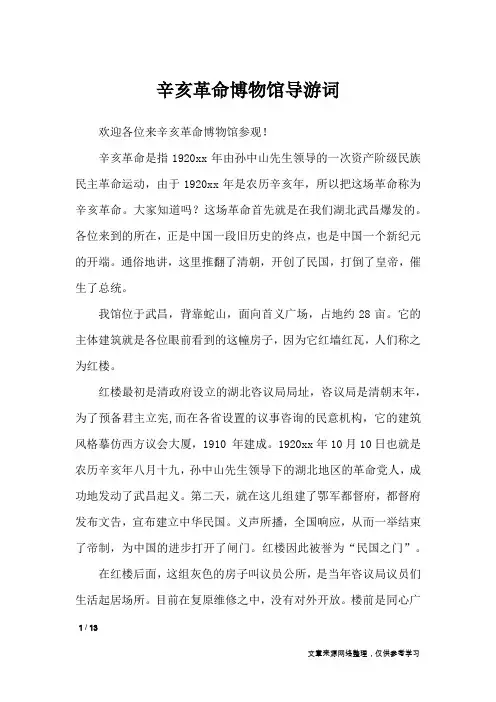
辛亥革命博物馆导游词欢迎各位来辛亥革命博物馆参观!辛亥革命是指1920xx年由孙中山先生领导的一次资产阶级民族民主革命运动,由于1920xx年是农历辛亥年,所以把这场革命称为辛亥革命。
大家知道吗?这场革命首先就是在我们湖北武昌爆发的。
各位来到的所在,正是中国一段旧历史的终点,也是中国一个新纪元的开端。
通俗地讲,这里推翻了清朝,开创了民国,打倒了皇帝,催生了总统。
我馆位于武昌,背靠蛇山,面向首义广场,占地约28亩。
它的主体建筑就是各位眼前看到的这幢房子,因为它红墙红瓦,人们称之为红楼。
红楼最初是清政府设立的湖北咨议局局址,咨议局是清朝末年,为了预备君主立宪,而在各省设置的议事咨询的民意机构,它的建筑风格摹仿西方议会大厦,1910 年建成。
1920xx年10月10日也就是农历辛亥年八月十九,孙中山先生领导下的湖北地区的革命党人,成功地发动了武昌起义。
第二天,就在这儿组建了鄂军都督府,都督府发布文告,宣布建立中华民国。
义声所播,全国响应,从而一举结束了帝制,为中国的进步打开了闸门。
红楼因此被誉为“民国之门”。
在红楼后面,这组灰色的房子叫议员公所,是当年咨议局议员们生活起居场所。
目前在复原维修之中,没有对外开放。
楼前是同心广1 / 13场,寓意是“两岸一心,和平统一”。
1961年,红楼经国务院公布为首批全国重点文物保护单位,经过多年的建设,我馆已成为纪念辛亥革命的标志性景点和全国有名的教育基地。
我馆布置有两个基本陈列:一个是以鄂军都督府旧址,也就是红楼为载体,布置的《鄂军都督府旧址复原陈列》,各位将会看到鄂军都督府成立初期的机构和格局;另一个是布置于西配楼的《辛亥革命武昌起义史迹陈列》,它展现了武昌起义的历史过程。
我们首先从《旧址复原陈列》开始。
从《格局图》中,我们可以大致了解到军政府成立初期的政府组织结构,这是非常简单的政府雏形了。
共设五个部,即参谋部、军令部、军务部、民政府、外交部,还有黎都督起居室、总监察长室、各部稽查长室等,但就是这样一个简单的地方政府,却改变了中国近代历史的进程。
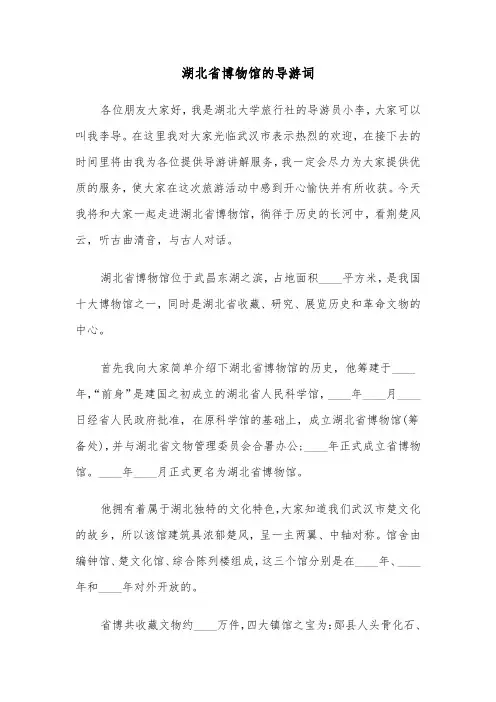
湖北省博物馆的导游词各位朋友大家好,我是湖北大学旅行社的导游员小李,大家可以叫我李导。
在这里我对大家光临武汉市表示热烈的欢迎,在接下去的时间里将由我为各位提供导游讲解服务,我一定会尽力为大家提供优质的服务,使大家在这次旅游活动中感到开心愉快并有所收获。
今天我将和大家一起走进湖北省博物馆,徜徉于历史的长河中,看荆楚风云,听古曲清音,与古人对话。
湖北省博物馆位于武昌东湖之滨,占地面积____平方米,是我国十大博物馆之一,同时是湖北省收藏、研究、展览历史和革命文物的中心。
首先我向大家简单介绍下湖北省博物馆的历史,他筹建于____年,“前身”是建国之初成立的湖北省人民科学馆,____年____月____日经省人民政府批准,在原科学馆的基础上,成立湖北省博物馆(筹备处),并与湖北省文物管理委员会合署办公;____年正式成立省博物馆。
____年____月正式更名为湖北省博物馆。
他拥有着属于湖北独特的文化特色,大家知道我们武汉市楚文化的故乡,所以该馆建筑具浓郁楚风,呈一主两翼、中轴对称。
馆舍由编钟馆、楚文化馆、综合陈列楼组成,这三个馆分别是在____年、____年和____年对外开放的。
省博共收藏文物约____万件,四大镇馆之宝为:郧县人头骨化石、曾侯乙编钟、越王勾践剑、元青花四爱图梅瓶。
可是由于今天时间的关系我们就只能重点游览被称为“天下第一剑”的越王勾践剑。
好,说话间我们现在来到的展有越王勾践剑的楚文化馆。
请大家跟紧我的脚步。
楚文化馆作为湖北省博物馆展馆的一翼,于____年____月建成开馆。
楚,既是国名,又是族名。
楚国在公元前____年被秦国灭掉,立国约有八百年。
二十世纪六十年代以来,湖北发掘了五千余座楚墓,出土的大量文物展现了楚国社会生活的各个方面。
楚文化作为先秦时期的一个区域文化,独具一格、自成一体、博大精深,是构成先秦华夏文明的重要组成部分。
该展览分为八个部分,集中地展出湖北地区出土的楚文物精华,力求全面展示楚文化的辉煌。
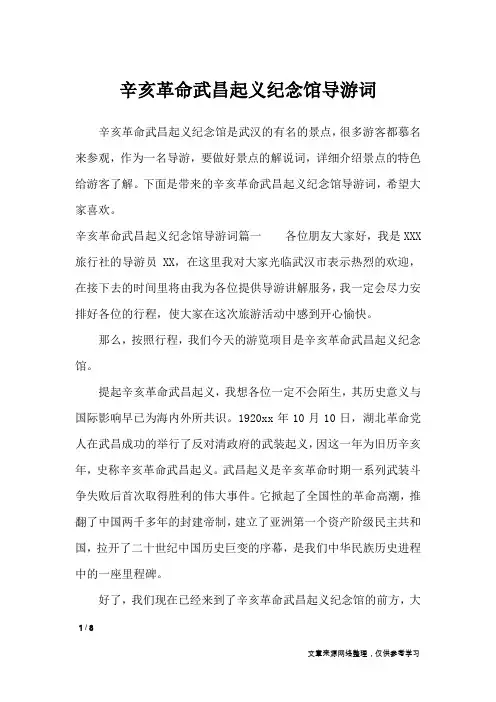
辛亥革命武昌起义纪念馆导游词辛亥革命武昌起义纪念馆是武汉的有名的景点,很多游客都慕名来参观,作为一名导游,要做好景点的解说词,详细介绍景点的特色给游客了解。
下面是带来的辛亥革命武昌起义纪念馆导游词,希望大家喜欢。
辛亥革命武昌起义纪念馆导游词篇一各位朋友大家好,我是XXX 旅行社的导游员XX,在这里我对大家光临武汉市表示热烈的欢迎,在接下去的时间里将由我为各位提供导游讲解服务,我一定会尽力安排好各位的行程,使大家在这次旅游活动中感到开心愉快。
那么,按照行程,我们今天的游览项目是辛亥革命武昌起义纪念馆。
提起辛亥革命武昌起义,我想各位一定不会陌生,其历史意义与国际影响早已为海内外所共识。
1920xx年10月10日,湖北革命党人在武昌成功的举行了反对清政府的武装起义,因这一年为旧历辛亥年,史称辛亥革命武昌起义。
武昌起义是辛亥革命时期一系列武装斗争失败后首次取得胜利的伟大事件。
它掀起了全国性的革命高潮,推翻了中国两千多年的封建帝制,建立了亚洲第一个资产阶级民主共和国,拉开了二十世纪中国历史巨变的序幕,是我们中华民族历史进程中的一座里程碑。
好了,我们现在已经来到了辛亥革命武昌起义纪念馆的前方,大1 / 8家看,这座红色砖木两层的建筑就是辛亥革命武昌起义纪念馆,因整个建筑为红色,所以我们武汉人便习惯称它为红楼。
大家会发现纪念馆的整个建筑和中国传统建筑的风格不同,它采用的是西式建筑风格,这是为什么呢?这还要从修建此楼的历史背景说起。
最初的红楼,是清朝政府为玩弄立宪骗局而设立的湖北省咨议局旧址。
在民族资产阶级的强烈要求下,当时清政府的最高统治者慈禧太后迫于外界压力,也为了应付革命,做出了立宪的姿态。
于是在1920xx年,清政府宣布预备立宪,宣称在北京设立咨政院,各省设咨议局,作为中央和地方咨询、议事的机构。
湖北咨议局于1920xx 年筹建,1920xx年建成。
建筑风格于西方国家议院的风格基本一致。
红楼上,“武昌起义军政府”和“辛亥革命武昌起义纪念馆”两块匾额是有宋庆龄所题写的。
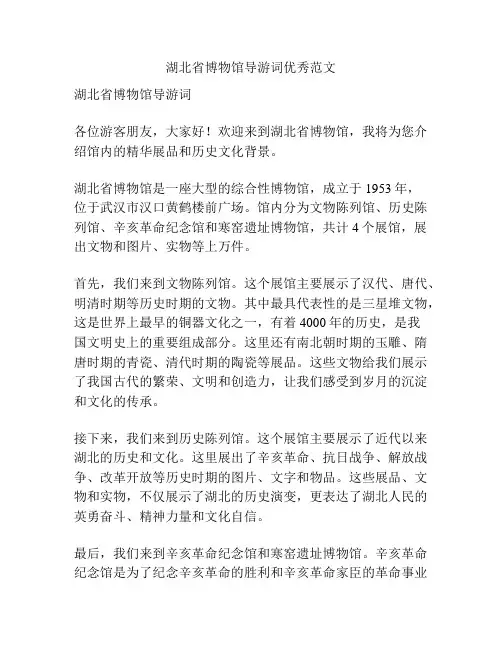
湖北省博物馆导游词优秀范文湖北省博物馆导游词各位游客朋友,大家好!欢迎来到湖北省博物馆,我将为您介绍馆内的精华展品和历史文化背景。
湖北省博物馆是一座大型的综合性博物馆,成立于1953年,位于武汉市汉口黄鹤楼前广场。
馆内分为文物陈列馆、历史陈列馆、辛亥革命纪念馆和寒窑遗址博物馆,共计4个展馆,展出文物和图片、实物等上万件。
首先,我们来到文物陈列馆。
这个展馆主要展示了汉代、唐代、明清时期等历史时期的文物。
其中最具代表性的是三星堆文物,这是世界上最早的铜器文化之一,有着4000年的历史,是我国文明史上的重要组成部分。
这里还有南北朝时期的玉雕、隋唐时期的青瓷、清代时期的陶瓷等展品。
这些文物给我们展示了我国古代的繁荣、文明和创造力,让我们感受到岁月的沉淀和文化的传承。
接下来,我们来到历史陈列馆。
这个展馆主要展示了近代以来湖北的历史和文化。
这里展出了辛亥革命、抗日战争、解放战争、改革开放等历史时期的图片、文字和物品。
这些展品、文物和实物,不仅展示了湖北的历史演变,更表达了湖北人民的英勇奋斗、精神力量和文化自信。
最后,我们来到辛亥革命纪念馆和寒窑遗址博物馆。
辛亥革命纪念馆是为了纪念辛亥革命的胜利和辛亥革命家臣的革命事业而建。
在这里,您可以看到伟大的辛亥革命精神,并通过实物和图片,了解辛亥革命时期的人民和历史。
寒窑遗址博物馆则是为了保护和展示我国已知最早的历史村落而建。
它不仅是中国历史学和考古学的重要研究基地,也成为国际上了解中国古代社会、宗教和文化的重要窗口。
以上就是我们馆内的主要展馆。
希望您在这里享受文化、感受历史、增长知识,领略到我们伟大祖国的辉煌历史和文化底蕴。
同时,也希望您遵守博物馆规定,爱护文物,保持文明参观,让我们共同努力,为中华文化的繁荣和发展做出贡献。
谢谢大家!湖北省博物馆导游词接下来,请跟我一起来到文物陈列馆的第一个展厅,看看展出的三星堆文物。
三星堆文化是距今约4000年前的古文明遗址,以密集分布的青铜器和玉器、象牙器、陶器等闻名于世。
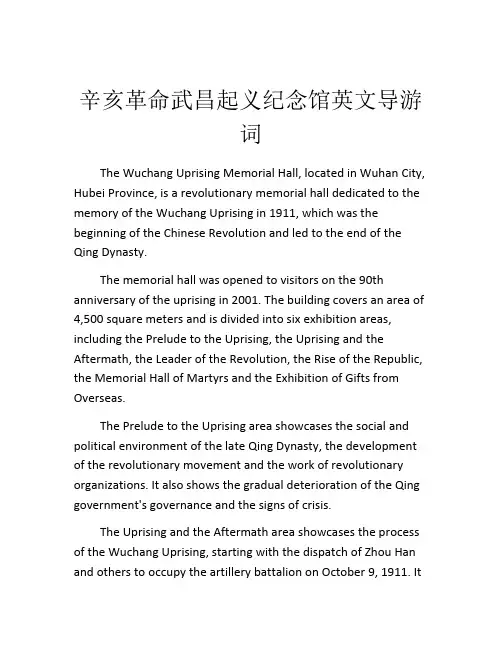
辛亥革命武昌起义纪念馆英文导游词The Wuchang Uprising Memorial Hall, located in Wuhan City, Hubei Province, is a revolutionary memorial hall dedicated to the memory of the Wuchang Uprising in 1911, which was the beginning of the Chinese Revolution and led to the end of the Qing Dynasty.The memorial hall was opened to visitors on the 90th anniversary of the uprising in 2001. The building covers an area of 4,500 square meters and is divided into six exhibition areas, including the Prelude to the Uprising, the Uprising and the Aftermath, the Leader of the Revolution, the Rise of the Republic, the Memorial Hall of Martyrs and the Exhibition of Gifts from Overseas.The Prelude to the Uprising area showcases the social and political environment of the late Qing Dynasty, the development of the revolutionary movement and the work of revolutionary organizations. It also shows the gradual deterioration of the Qing government's governance and the signs of crisis.The Uprising and the Aftermath area showcases the process of the Wuchang Uprising, starting with the dispatch of Zhou Han and others to occupy the artillery battalion on October 9, 1911. Italso details the establishment of the Hubei Military Government, the joint efforts of the revolutionaries and the people, and the development of the revolution across the country, which laid the foundation for the founding of the Republic of China.The Leader of the Revolution area is dedicated to Dr. Sun Yat-sen, the father of the Chinese Revolution. It introduces his personal experiences, political thoughts and revolutionary activities, as well as his contribution to the revolution and the founding of the Republic of China.The Rise of the Republic area showcases the process of the revolution from the establishment of the Hubei Military Government to the founding of the Republic of China. It highlights the important role of the people and the military in the establishment of the new government.The Memorial Hall of Martyrs is dedicated to the revolutionaries who participated in the Wuchang Uprising and sacrificed their lives. The martyrs' names and deeds are engraved on the walls, and their courage and sacrifice are remembered and honored here.The Exhibition of Gifts from Overseas area showcases the gifts given to China by foreign countries in recognition of the achievements of the Chinese Revolution. These include portraits, medals, and souvenirs from various countries around the world.Overall, the Wuchang Uprising Memorial Hall is a must-visit attraction for anyone interested in Chinese history and culture. It provides visitors with a comprehensive and systematic understanding of the events and achievements of the Wuchang Uprising and the Chinese Revolution, and showcases the spirit of patriotism, revolution and sacrifice of the Chinese people.。
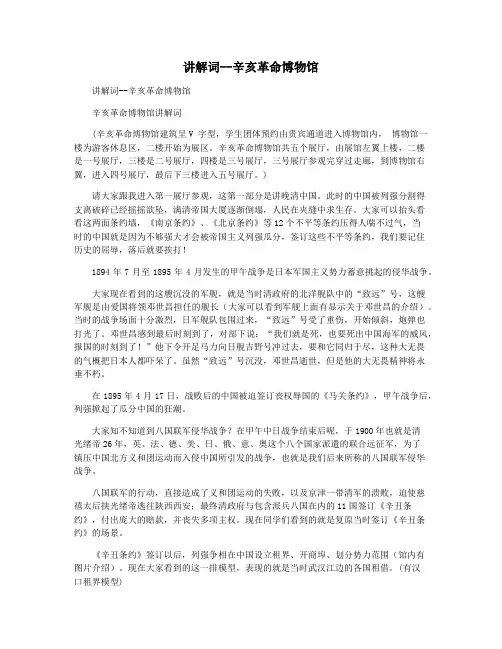
讲解词--辛亥革命博物馆讲解词--辛亥革命博物馆辛亥革命博物馆讲解词(辛亥革命博物馆建筑呈V 字型,学生团体预约由贵宾通道进入博物馆内,博物馆一楼为游客休息区,二楼开始为展区。
辛亥革命博物馆共五个展厅,由展馆左翼上楼,二楼是一号展厅,三楼是二号展厅,四楼是三号展厅,三号展厅参观完穿过走廊,到博物馆右翼,进入四号展厅,最后下三楼进入五号展厅。
)请大家跟我进入第一展厅参观,这第一部分是讲晚清中国。
此时的中国被列强分割得支离破碎已经摇摇欲坠,满清帝国大厦逐渐倒塌,人民在夹缝中求生存。
大家可以抬头看看这两面条约墙,《南京条约》、《北京条约》等12个不平等条约压得人喘不过气,当时的中国就是因为不够强大才会被帝国主义列强瓜分,签订这些不平等条约,我们要记住历史的屈辱,落后就要挨打!1894年7月至1895年4月发生的甲午战争是日本军国主义势力蓄意挑起的侵华战争。
大家现在看到的这艘沉没的军舰,就是当时清政府的北洋舰队中的“致远”号,这艘军舰是由爱国将领邓世昌担任的舰长(大家可以看到军舰上面有显示关于邓世昌的介绍)。
当时的战争场面十分激烈,日军舰队包围过来,“致远”号受了重伤,开始倾斜,炮弹也打光了。
邓世昌感到最后时刻到了,对部下说:“我们就是死,也要死出中国海军的威风,报国的时刻到了!”他下令开足马力向日舰吉野号冲过去,要和它同归于尽,这种大无畏的气概把日本人都吓呆了。
虽然“致远”号沉没,邓世昌逝世,但是他的大无畏精神将永垂不朽。
在1895年4月17日,战败后的中国被迫签订丧权辱国的《马关条约》,甲午战争后,列强掀起了瓜分中国的狂潮。
大家知不知道到八国联军侵华战争?在甲午中日战争结束后呢,于1900年也就是清光绪帝26年,英、法、德、美、日、俄、意、奥这个八个国家派遣的联合远征军,为了镇压中国北方义和团运动而入侵中国所引发的战争,也就是我们后来所称的八国联军侵华战争。
八国联军的行动,直接造成了义和团运动的失败,以及京津一带清军的溃败,迫使慈禧太后挟光绪帝逃往陕西西安;最终清政府与包含派兵八国在内的11国签订《辛丑条约》,付出庞大的赔款,并丧失多项主权。
本文部分内容来自网络整理,本司不为其真实性负责,如有异议或侵权请及时联系,本司将立即删除!== 本文为word格式,下载后可方便编辑和修改! ==辛亥革命纪念馆导游词导语:我知道武昌是辛亥革命的发源地,辛亥革命博物馆又名武昌红楼,是辛亥革命中鄂军都督府旧址。
以下小编为大家介绍辛亥革命纪念馆导游词文章,欢迎大家阅读参考!辛亥革命纪念馆导游词欢迎各位来辛亥革命博物馆参观!辛亥革命是指1911年由孙中山先生领导的一次资产阶级民族民主革命运动,由于1911年是农历辛亥年,所以把这场革命称为辛亥革命。
大家知道吗?这场革命首先就是在我们湖北武昌爆发的。
各位来到的所在,正是中国一段旧历史的终点,也是中国一个新纪元的开端。
通俗地讲,这里推翻了清朝,开创了民国,打倒了皇帝,催生了总统。
我馆位于武昌,背靠蛇山,面向首义广场,占地约28亩。
它的主体建筑就是各位眼前看到的这幢房子,因为它红墙红瓦,人们称之为红楼。
红楼最初是清政府设立的湖北咨议局局址,咨议局是清朝末年,为了预备君主立宪,而在各省设置的议事咨询的民意机构,它的建筑风格摹仿西方议会大厦,1910 年建成。
1911年10月10日也就是农历辛亥年八月十九,孙中山先生领导下的湖北地区的革命党人,成功地发动了武昌起义。
第二天,就在这儿组建了鄂军都督府,都督府发布文告,宣布建立中华民国。
义声所播,全国响应,从而一举结束了帝制,为中国的进步打开了闸门。
红楼因此被誉为“民国之门”。
在红楼后面,这组灰色的房子叫议员公所,是当年咨议局议员们生活起居场所。
目前在复原维修之中,没有对外开放。
楼前是同心广场,寓意是“两岸一心,和平统一”。
1961年,红楼经国务院公布为首批全国重点文物保护单位,经过多年的建设,我馆已成为纪念辛亥革命的标志性景点和全国有名的教育基地。
我馆布置有两个基本陈列:一个是以鄂军都督府旧址,也就是红楼为载体,布置的《鄂军都督府旧址复原陈列》,各位将会看到鄂军都督府成立初期的机构和格局;另一个是布置于西配楼的《辛亥革命武昌起义史迹陈列》,它展现了武昌起义的历史过程。
辛亥革命纪念馆讲解词1. 嗨,大家好!我今天要带你们走进辛亥革命纪念馆呢。
你们知道吗?每次我路过这里,就好像听到孙中山先生在说:“革命尚未成功,同志仍需努力。
”就像我们做数学题,一道难题摆在面前,你以为快解出来了,其实还有好多步骤要做呢。
我和同桌有一次做一道超难的数学应用题,他想放弃,我就想起孙中山先生的这句话,跟他说:“你看,孙中山先生那么难的革命都不放弃,我们这道题算啥呀。
”然后我们一起努力,最后真的解出来了。
这就是一种坚持的力量,就像辛亥革命时期的先辈们一样,不管遇到多少困难,都勇往直前。
2. 来,咱们瞧瞧这纪念馆里的东西。
我仿佛看到那些革命志士在商量:“咱们一定要推翻封建帝制,让老百姓过上好日子!”这就好比我们在学校参加大扫除,大家都想把教室弄得干干净净的。
班长说:“咱们不能只打扫自己那块儿,得让整个教室都整洁起来。
”有个同学偷懒,另一个同学就说:“大家都为了教室好,你怎么能这样呢?”大家七嘴八舌地劝他,最后他也加入了。
这就是大家为了一个目标齐心协力的感觉,辛亥革命的先辈们也是为了全国人民能过上新生活才团结起来战斗的。
3. 看这里,这里展示着当时的一些物品。
我能想象到那时候的人们互相鼓励:“别怕,我们的行动是正义的,一定能成功!”就像我参加跑步比赛的时候,心里特别害怕跑不好。
我的好朋友拍着我的肩膀说:“别怕,你平时跑得那么快,这次肯定行,这是你擅长的呀。
”旁边还有其他同学喊:“加油,加油!”这一声声鼓励就像给我注入了力量。
辛亥革命时期的人们也是靠着彼此的鼓励,在艰难的革命道路上坚定地走下去。
4. 哇哦,这个场景真让人震撼!我好像听到有人喊:“我们要为自由民主而战!”这就像我们在班级里选班干部,大家都想要一个公平民主的选举。
有个同学说:“我们不能让老师直接指定,要自己投票选。
”另一个同学也说:“对呀,这样才公平,每个人都有表达自己想法的权利。
”大家热烈讨论,最后达成了一致。
辛亥革命就是为了给全国人民争取自由民主的权利,就像我们在班级里为了公平选举而努力一样。
辛亥革命博物馆导游词辛亥革命博物馆导游词游客朋友们:通过地下通道,我们来到了首义广场的南端。
眼前的这组浮雕是用铜铸的,这些革命党人手握枪,高举旗帜,眼神坚毅充满希望!整个浮雕寓意:走向共和。
值得注意的是革命党人手中的枪,这个就是鼎鼎大名的汉阳造。
广场中心是大型喷泉。
前面的红色建筑就是为辛亥革命百年而建造的新博物馆,想必早就引起大家的注意了。
整个建筑三分之一在地下,另一部分在地面上。
为什么是这种建筑布局呢?我们边走边说,整个馆建筑面积达2.21万平方米,高22.5米,我们现在是从正面看,它宽屋面,高台基的构架传承了楚国建筑特色。
体布局以红色沙岩为基调,外观呈“V”字型。
红色是楚文化特色,同时又与红楼建筑体的色彩协调一致。
V字型寓意革命胜利。
待会儿,我们从侧门出来的时候,我会告诉大家为什么博物馆一部分在地下的的原因。
现在我们处在的是V字型开口处的下方,请大家拿出你们的身份证,刷身份证进入馆内。
注意保护好自己的随身物品。
馆内共有5个展厅,1个多功能展厅以及学术报告厅、藏品库等。
整个展厅是按照时间顺序来排列的。
分晚清中国、革命原起、武昌起义、创建共和、辛亥百年5个部分。
首先我们看见的序厅,里面是一组名为“共和之基”的雕塑,运用了浮雕和圆雕形式,展示了革命党人前赴后继创建共和的宏大场面,武昌首义的成功,奠定了共和之基。
我们进入展厅后,首先映入眼帘的是“条约墙”,12条不平等条约的名称被刻在两侧青黑色的墙壁上给人庄严沉重的之感。
《南京条约》是和英国签订的。
1840年列强用鸦片和大炮打开了中国的大门,英国在这个条约中获得赔款,白银2100万两,割香港。
《五口通商章程》就是我们熟知的望厦条约是1844年(道光二十四年)7月3日清朝与美国在澳门的望厦村签订的不平等条约,也是清政府与美国签订的第一个不平等条约。
《天津条约》是同英,法,美,日,俄签订的。
《北京条约》是同英,法,日,俄,葡萄牙签订的。
中俄勘分西北界约记,损失了44万平方公里《瑷珲条约》割让给俄国六十万平方公里。
武汉辛亥革命纪念馆详细介绍
武汉辛亥革命纪念馆位于武昌区小东门,由辛亥革命博物馆、辛亥革命纪念公园、辛亥革命武昌起义纪念馆和辛亥革命烈士纪念馆等部分组成。
其前身为1911年10月10日武昌起义爆发后建立的湖北军政府和中华民国临时政府成立办公地——军政府旧址。
1912年4月,在此设立武昌城中的“中华民国临时大总统”府,正式宣布实行“总统制”,是为“中华民国第一任临时大总统”,并于1913年12月10日就职。
1928年3月10日改为“湖北军政府”,国民政府迁至武汉。
1949年3月,武昌解放前夕,国民党军队退至汉口,国民党在此继续办公,1949年8月15日,中国人民解放军占领武昌城后,在此设立湖北省政府。
从此武汉成为中国革命的政治中心。
纪念馆占地面积12,000平方米,建筑面积7,800平方米。
馆内设有两个展厅:一个是序厅;一个是革命纪念厅。
其中革命纪念厅陈列有大量珍贵的历史资料和文物实物。
辛亥革命博物馆馆藏文物史料共计40,700余件。
—— 1 —1 —。
(展馆外)各位领导、各位观众:大家好!欢迎来到辛亥革命博物馆,辛亥革命博物馆是为了纪念辛亥革命武昌首义100周年而兴建的一座现代化的专题博物馆,也是目前全国规模最大的研究辛亥革命历史的专题博物馆。
馆址在首义文化区的中轴线上,建筑面积2.2万平方米。
整个展馆建筑以最具荆楚特色的“楚国红”为主色调,整体造型呈一个V 字型,寓意着胜利,也预示着武汉的腾飞。
展馆分为地下一层,地上三层。
您现在看到的是大型雕塑《共和之基》,整座雕塑(长50米,高8米,)呈“V”字型走向,以浮雕结合圆雕为主要表现形式,包括起义背景、武昌首义、创建共和三个部分,您看,这一组雕塑主要表现武昌首义的过程,既突出了“敢为天下先”的首义精神,又体现出首义中的民众力量。
首先请参观第一部分——晚清中国。
这一展厅向您介绍辛亥革命爆发的社会背景。
您现在看到的是一组条约墙,在这里记载了(手示)从1842年中英《南京条约》到1887年中葡《北京条约》,列强与清政府签订了的多达24个不平等条约,攫取了各种特权,民族危机日益深重。
在这里,(手示)两面条约墙向中心倾斜,沉重的锁链串起摇摇欲坠的条约墙。
(手示)条约墙的尽头展现的是被列强分割的支离破碎的《晚清时局图》,整个造型寓意在西方列强的压迫下,国家大厦即将颠覆,人民在夹缝中求生存的危难局面。
1894年甲午战后,中国被迫签订丧权辱国的《马关条约》,列强掀起了瓜分中国的狂潮,中国面临空前的民族危机和社会危机。
1900年,列强以保护使馆和侨民为借口,组成英,美,俄,日,法,德,意,奥八国联军联合进攻中国,攻陷北京。
次年九月七日,(手示)清政府代表奕劻(kuang)、李鸿章与列强在北京签订《辛丑条约》。
中国共赔款4.5亿两白银,分39年还清,本息共计9.8亿两。
这是中国近代史上赔款数额最大的不平等条约,极大地加重了中国人民的负担,严重损坏了中国的主权。
三、沉沦的大清帝国列前打开大清国门后,争相开商埠,设租界,划分势力范围。
辛亥革命武昌起义纪念馆导游词尊敬的各位游客,大家好!欢迎来到辛亥革命武昌起义纪念馆。
我们今天要带您们领略辛亥革命的历史,琢磨辛亥革命武昌起义背后的故事。
我们将会带领大家参观这座严谨整洁、古色古香的纪念馆,群众可以一睹展览室和内部藏品。
在这座建筑里,您将可以了解到它所承载的相关历史和故事。
我们的起点是中国历史上最重要的事件之一——辛亥革命。
辛亥革命是中国近现代史上的一次伟大的社会变革,它的目标是推翻清朝政府并建立民主共和国。
这次革命的中心地带是武汉城,是被中华民族视为反帝反封建斗争的起点。
在1911年10月10日,一批高级将领在武昌举行启动了辛亥革命的武昌起义。
在那个时候,武昌的铁路局起义并非是突如其来。
武昌的士兵、市民和各界人士长期以来的团结合作,他们为建立新的民主政府而奋斗,这成就了后来的辛亥革命和新中国的建立。
进展到展览室,我们可以看到九幅油画:分别是“吹牛会”、“洋务运动”、“义和团运动”、“国门危急”、“葭芦岛海战”、“辛亥革命爆发”、“辛轻轻斩蒋”、“天下大同”和“无神论”。
这些油画集中展现了辛亥革命前后各类社会运动的人物和情景,让我们可以深入了解辛亥革命的内部和外部背景。
通过这些油画,我们可以更好地理解那个时代中中国人民的思考方式、文化背景和社会生态。
在展览室的东端,是一张旧地图。
地图标明了中国在革命前及时点的版图、各处摆出的割让地和势力范围。
在辛亥革命爆发之前,清朝政府一直处于土地沦丧的过程中,国家日趋衰落。
清政府的不幸是,在这个时刻、以这种清晰的方式,向外界展示了它的最大弱点。
地图显现这种弱点,同时也使我们想到了中国切身问题的根源:国际地位的损失和内外的重重挑战。
在展览室的北端,尤其令人提防的是毛泽东雕像。
毛主席曾经在武昌起义后登上了武昌长江大桥。
武昌起义激发起了中国革命的各种激情。
毛泽东的来到让这种情感变得更加深刻和有力量,对于人民利益和民主革命的最高追求,他为此奋斗了毕生。
毛泽东的雕像就代表了当时革命人民的的信仰和力量。
湖北辛亥革命博物馆导游词欢迎各位来辛亥革命博物馆参观!辛亥革命是指1911年由孙中山先生领导的一次资产阶级民族民主革命运动,由于1911年是农历辛亥年,所以把这场革命称为辛亥革命。
大家知道吗?这场革命首先就是在我们湖北武昌爆发的。
各位来到的所在,正是中国一段旧历史的终点,也是中国一个新纪元的开端。
通俗地讲,这里推翻了清朝,开创了民国,打倒了皇帝,催生了总统。
我馆位于武昌,背靠蛇山,面向首义广场,占地约28亩。
它的主体建筑就是各位眼前看到的这幢房子,因为它红墙红瓦,人们称之为红楼。
红楼最初是清政府设立的湖北咨议局局址,咨议局是清朝末年,为了预备君主立宪,而在各省设置的议事咨询的民意机构,它的建筑风格摹仿西方议会大厦,1910年建成。
1911年10月10日也就是农历辛亥年八月十九,孙中山先生领导下的湖北地区的革命党人,成功地发动了武昌起义。
第二天,就在这儿组建了鄂军都督府,都督府发布文告,宣布建立中华民国。
义声所播,全国响应,从而一举结束了帝制,为中国的进步打开了闸门。
红楼因此被誉为“民国之门”。
在红楼后面,这组灰色的房子叫议员公所,是当年咨议局议员们生活起居场所。
目前在复原维修之中,没有对外开放。
楼前是同心广场,寓意是“两岸一心,和平统一”。
1961年,红楼经国务院公布为首批全国重点文物保护单位,经过多年的建设,我馆已成为纪念辛亥革命的标志性景点和全国有名的教育基地。
我馆布置有两个基本陈列:一个是以鄂军都督府旧址,也就是红楼为载体,布置的《鄂军都督府旧址复原陈列》,各位将会看到鄂军都督府成立初期的机构和格局;另一个是布置于西配楼的《辛亥革命武昌起义史迹陈列》,它展现了武昌起义的历史过程。
我们首先从《旧址复原陈列》开始。
从《格局图》中,我们可以大致了解到军政府成立初期的政府组织结构,这是非常简单的政府雏形了。
共设五个部,即参谋部、军令部、军务部、民政府、外交部,还有黎都督起居室、总监察长室、各部稽查长室等,但就是这样一个简单的地方政府,却改变了中国近代历史的进程。
鄂军都督府会议厅原来是咨议局议事堂。
武昌起义第二天,也就是1911年10月11日湖北革命党人和起义官兵在此集会,推举原清军第21混成协统领黎元洪为都督。
在主席台左边是黎元洪被推为都督后,军政府发布的第一份文告。
当时,革命党人请大都督在上面签字印发,黎元洪拒不签字,连声说“莫害我”,最后革命党人李翊东提笔代签了一个“黎”字,这份文告才得以面世。
这份布告的发布对于稳定人心是起了一定作用的。
布告的落款时间是黄帝纪元四千六百零九年八月二十日为什么会有这种奇怪的落款呢?1911年是清宣统三年,但革命党发动起义就是为了推翻清王朝,所以不会采用宣统年号纪年,加之革命党宣称自己是炎黄子孙,所以就从传说中汉族人的祖先黄帝算起,到1911年正是四千六百零九年。
八月二十日是阴历,转换成公元历法的话就是10月11日。
我国使用公元历法是从民国元年元旦开始,即1912年1月1日。
主席台正中布置的一面旗帜,叫十八星旗,是武昌起义的军旗。
十八颗黄星,是代表山海关内十八个省份的炎黄子孙,红底是鲜血,黑色是铁,是武器,主题和象征意义是十八省的炎黄子孙团结起来,以“铁血”即武力推翻满清王朝的统治。
在台口右边有一张图片,反映的是1912年4月孙中山先生访鄂期间,受到湖北各界欢迎的情景。
1912年4月,孙中山先生在辞去临时大总统职务后,就首先到湖北访问。
4月10日这天,孙中山在此发表演讲。
外交部的设置是鄂军都督府代行中央政府职权的重要标志。
各位知道,只有一个主权国家才有外交部。
在1912年元旦南京临时政府成立以前,鄂军都督府实际上在军事、外交等方面行使中央军政府的职权。
它通过外交部对各国发布照会,宣示革命政权的政策,以取得各国的外交支持。
这份《中立布告》,是鄂军都督府取得的重大外交成果。
军政府成立之初,就给汉口的五国领事发布过外交照会,呼吁承认中华民国,但五国迟迟不答复。
直到10月17日民军和清军在汉口刘家庙展开激战,民军大获全胜,这时,五国看到革命党人力量强大,就联名发布了一纸布告,承认民军是和清军对等的军事实体,他们保持中立。
这份布告实际上承认了民军的地位,对清王朝是一个打击。
当然,这份布告也只是一纸空文,五国后来在暗中支持袁世凯,帮助袁获得了总统的宝座。
胡瑛曾任外交部部长一职。
都督会客室和都督会议室是黎元洪在红楼活动的重要场所。
1912年4月,孙中山先生访问武汉,曾在都督会客室会见过湖北军政界人士。
黎都督起居室是黎元洪任都督之初的住所。
黎元洪(1864——1928)字宋卿,是湖北黄陂人。
今天汉口有一条黎黄陂路,就是纪念黎元洪的。
黎元洪原来是清军第21混成协统领。
为借重他的声望,武昌起义第二天,革命党人推举他作鄂军都督府都督,开始黎元洪态度强硬,不愿与革命党人合作,被安置在这间屋子里。
他不吃不喝,象个“泥(黎)菩萨”。
后来因为武汉三镇光复和革命形势迅猛发展,黎元洪转变了态度,同意出任都督。
侍卫官室正对黎都督起居室。
侍卫官的主要职责是负责都督的安全保卫及饮食起居。
最初几天实际上是执行软禁和监视黎都督的职责。
顾问官室和秘书官室是都督黎元洪的咨询幕僚机构和重要的办事机构。
革命党人宋教仁曾在秘书官室起草了著名的《鄂州临时约法》,《鄂州临时约法》是第一个具有资产阶级宪法性质的法典,它成为以后南京临时政府颁布的《临时约法》的蓝本。
军事会议室是都督府召开军事会议的专门场所,许多重大军事决策在此形成。
阳夏保卫战中,黄兴曾在此召开过军事会议。
墙上有一幅地图,反映的是当年阳夏战争的形势。
其中红蓝线代表两军运动路线,可以看出汉口、汉阳两地是当年的战场,而当年的汉口称为夏口,所以这场战争简称阳夏战争。
参谋部是鄂军都督府最初设置的四部之一。
其职责为辅佐都督,制定作战计划。
都督府草创之际,军民大政,参谋部主持最多。
总监察长室和各部稽查长室的设置则反映了当时革命党人良好的精神风范。
首先我们从刘公说起,刘公是湖北襄阳人,出身于巨富之家,早年留学日本,加入了孙中山组建的中国同盟会,并创办了另一个革命组织共进会。
1910年回国,家里人交给他两万两银票,叫他去北京捐一个道台,也就是去买个官,但刘公将这笔巨款无偿捐给了武昌起义的指挥机关,用作购买枪械和起义的后勤保障经费。
鉴于他资深革命党人的地位和为武昌起义做出的贡献,起义前在推选未来的政府成员时,刘公被推为政府总理。
但最初组建的鄂军都督府中没有刘公的位置,有人就为他抱屈,刘公却不以为然,认为革命的目标已完成,应该让贤者执政,自己退居一旁进行监督就可以了。
他“功成不居”的风范为大家钦佩,所以推举他为总监察长。
蔡济民是武昌起义的军事指挥人员,他带领一支部队攻进了湖广总督署,为武昌起义的胜利立下了汗马功劳。
起义后被公推委用为各部稽查长,蔡济民一生追随孙中山先生,后来在护法斗争中为地方军阀所杀。
黄兴称赞他是“鄂省军中之巨擘”。
所谓“巨擘”,就是可以竖大拇指的人物。
民政部不同于今天的民政部,它是相对于军政而言的,其主要职责为负责地方行政事务,部长相当于今天省长的职权。
这张照片中的人物叫汤化龙,是原湖北咨议局议长,当年正是在红楼办公。
武昌起义成功后,汤化龙约集原咨议局的立宪派人士,与革命党人、旧军官联合组建了鄂军都督府,并被推为民政部首任部长。
军令部是鄂军都督府最初设置的四部之一。
主要职责为秉承都督命令,发布军令,调遣军队。
都督黎元洪曾经兼任过军令部部长一职。
军务部主要负责军务行政、军队后勤工作。
革命党人孙武、张振武曾分任军务部正、副部长。
后来蒋翊武也出任过军务部副部长一职,“首义三武”均汇集于此部。
现在我们一起来参观《辛亥革命武昌起义史迹陈列》。
此陈列分为七个部分,以九个展厅全景式地展现了武昌起义历史。
序厅正面弧线是一组与武昌起义相关的人物群像。
主题是在孙中山先生的旗帜下,在同盟会和同盟会中部总会的推动下,湖北革命党人领导和发动了1911年10月10日的武昌起义。
画面下方的一行立体字是提示我们永远铭记的日子:1911年10月10日。
人物像下方影像是取材于天安门广场人民英雄纪念碑浮雕,反映的是湖北新军攻占湖广总督署的场景。
鸦片战争后的19世纪末,帝国主义国家掀起了瓜分中国的狂潮。
素有“九省通衢”之称的武汉也未能逃过列强的魔爪。
自1861年英国在汉口建立租界始,德、俄、法、日等国也相继在今天汉口江汉关至黄浦路一带建立租界。
列强以租界为据点,对湖北进行政治、经济、文化上的侵略与渗透;与此同时,封建专制统治也日益深重,在双重压迫之下,广大农民流离失所,苦不堪言。
面对中国社会的内忧外患,统治阶级内部也不乏一些有识之士,湖广总督张之洞就是一位。
这位张公是推动湖北走向近代化的重要人物。
为了挽狂澜于既倒、扶大厦于将倾,他在湖北开始推行耸动中外视听的“湖北新政”。
其主要措施有三条:一是办工厂。
最有名的是汉阳兵工厂和汉冶萍钢铁联合企业。
二是练新军。
甲午战败,张之洞深受刺激,认为军力不强是致败之因,所以开始在湖北编练一支有别于清八旗的“新”军。
新军除了武器装备、服装有新特点外,张之洞还大力提倡读书人当兵,投笔从戎在当时竟成为时尚,这就为革命党人在新军中宣传鼓动新军起义埋下了伏笔。
到张之洞离任时,他给湖北留下了两支部队:第八镇(师)和第二十一混成协(旅),共计约1万5千人。
三是兴教育。
人才的匮乏也让张之洞痛心疾首,新政期间,张之洞开办了许多以传授西学西技为内容的新式学堂,当时流传一首《学堂歌》,其中有一句说:“湖北省,二百堂,武汉学生五千强”,以说明湖北教育的兴盛。
张之洞还派遣大量留学生远涉重洋赴日本、美国、西欧求学。
其中尤其以派赴日本为多,当时在日本的中国留学生中湖北籍人数位居第一。
后来的辛亥革命领袖黄兴、宋教仁和吴禄贞等都是张之洞派到海外的留学生。
欧风美雨的冲击和张之洞在湖北的新政,客观上为中国的变局准备了条件。
清末湖北的反清革命发端于1900年的自立军运动。
首领为唐才常、傅慈祥等人,他们密谋发动“勤王”运动,以逼迫慈禧太后归政光绪,推行君主立宪制。
但事败,唐、傅被杀。
吴禄贞也参加了自立军运动,失败后远赴日本,得以侥幸逃脱。
在日本他与其他留学生有缘见到了孙中山先生,并接受了孙中山的革命思想。
他们或创办报刊鼓吹革命;或接受指示,回国起义;或创办革命团体,联络同志,发动军队。
湖北第一个革命组织科学补习所在张难先、朱元成、吕大森、曹亚伯等志士组织之下成立了。
这幅画中昂然卓立的年轻人,名叫王汉,是科学补习所重要成员。
他奉行暗杀主义,认为杀掉几个清廷大官就可以动摇清朝统治根基;于是乔装改扮,追杀清户部侍郎(相当于财政部副部长)铁良,可惜射术未精,结果以身殉义。
他在临行前,给新婚八个月的妻子留下一首绝笔诗《别内》,最后两句是“若使断头成永诀,愿卿含笑贺孤魂”,表现了王汉视死如归的英雄气概。